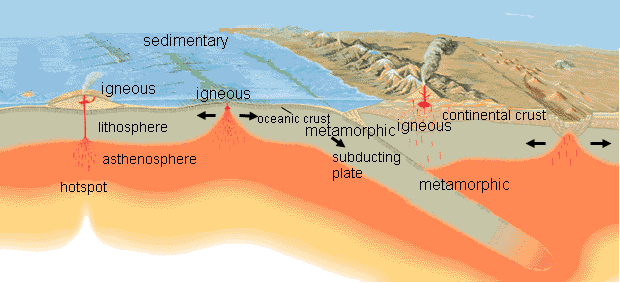BACKGROUND:
Rocks form mainly within the crust of the Earth. Igneous
rocks are formed when molten magma formed in the lithosphere cools and
crystallizes into solid rock. Magma cools slowly inside the Earth, forming
rocks like granite, which have large minerals that can be seen with the
naked eye. These are called plutonic igneous rocks. Quick cooling magmas are
generally erupted onto the Earth’s surface called volcanic rocks.

Sedimentary rocks are formed only on the surface of the
Earth. Sedimentary rocks form at the Earth’s surface in two main ways: (1)
from clastic material (pieces of other rocks or fragments of skeletons)
which have become cemented together, and (2) by chemical mechanisms
including precipitation and evaporation. There are many environments
associated with sedimentary rock formation, including oceans, lakes,
deserts, rivers, beaches, and glaciers. They may form at all types of plate
boundaries, but the thickest sedimentary rock accumulations occur at
convergent plate boundaries.
Metamorphic rocks are formed mainly in the lithosphere,
wherever there is high pressure and high temperature. If the pressure and
temperature are too high, metamorphic rock will melt and become magma. The
areas where metamorphic rocks form tend to be very close to those where
igneous rocks form.
The key objective of this unit is to emphasize that rock
formation can be conceptualized as a very dynamic system called the Rock
Cycle. The Rock Cycle is driven by the Plate Tectonic Cycle.
PROCEDURE:
- In this exercise, the students locate where rocks are formed within
the context of plate tectonics. Review igneous, sedimentary, and
metamorphic rocks and their origins. Discuss the various environments
where rocks are created. Ask the students to help you fill in the
environments that they think might create the three types of rocks.
- In the diagram to the left go over which rocks are created. In
converging zones, such as subduction, obduction, and collision,
metamorphic rocks are always created. However, only in subduction does
igneous rock form. Sedimentary rocks will form as the mountains, erode
and sediments settle into basins.
At diverging or rift zones igneous rocks are formed. Sedimentary
rocks will form if the area is submerged, like in the mid-Atlantic rift
zone. Metamorphic rocks can be formed as the plates move the rocks
apart, but it will be only localized. At transform or slip-slide
boundaries metamorphic rocks form.
Sedimentary rocks form as an overlay to all these plate interactions.